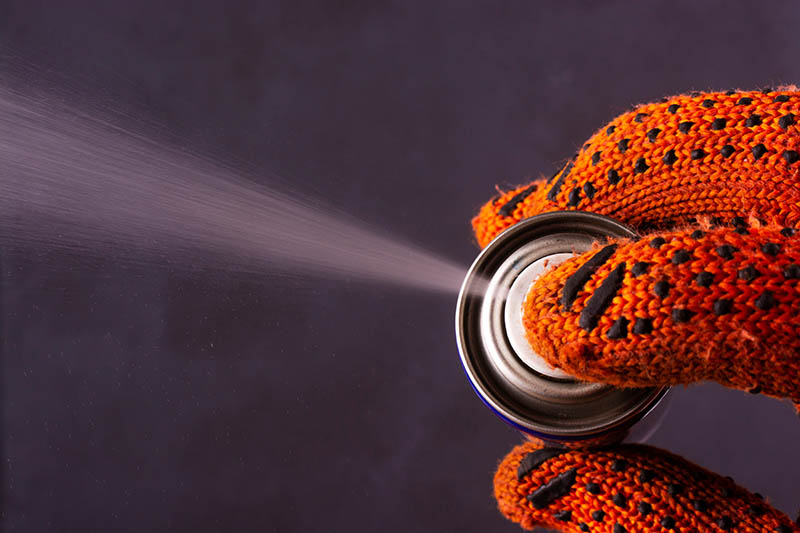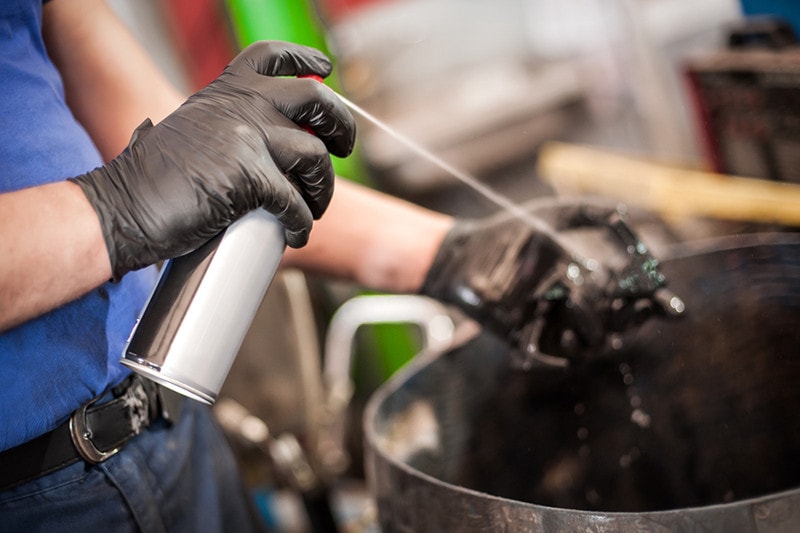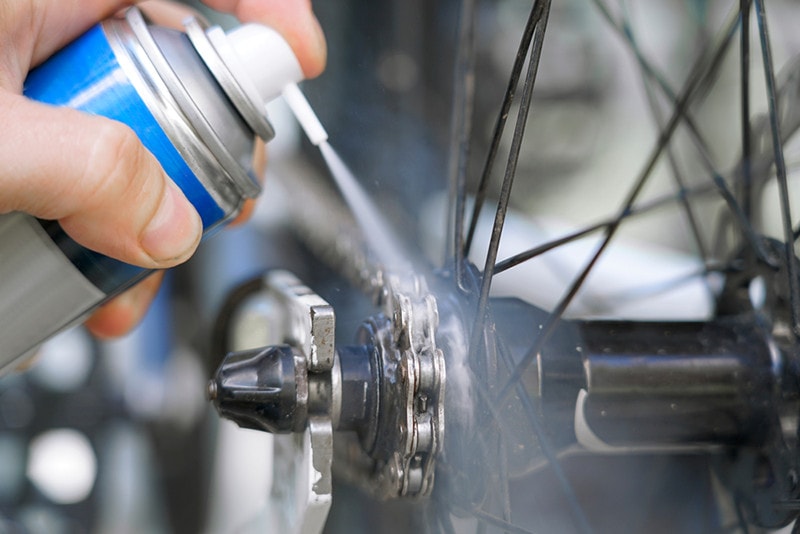Silicone Spray vs. WD-40: What’s the Difference?
-
Pete Ortiz
- Last updated:
Having a squeaking door or a jammed nut is often a call to explore some of the best lubricants the market has to offer. Most people opt for silicone spays or lubricants like WD-40, which both have a wide consumer base and share many similarities. But which product to use in a particular situation is a difficult question, so it’s best to find out the differences and uses of each.
This article will compare WD-40 and silicone sprays to help you learn the differences and decide which is best suited to specific applications.
Overview of WD-40
Many people believe WD-40 is a universal lubricant. But you would be wrong to think so. WD-40 is actually an American brand name and the trademark of a deep penetrating oil that is commonly used to remove rust and prepare metallic surfaces for paint. It is manufactured by WD-40, formerly known as the Rocket Chemical Company.
In 2014, the renowned brand was inducted into the International Space & Air Hall of Fame at the San Diego Air & Space Museum. Also, during the same decade, the company’s sales jumped by over 2.5 times from $27 to $70.2 million between 2008 and 20211.
The company’s founder, Iver Norman Lawson, formulated the water-displacing lubricant after 40 attempts. Thus, the origin of its name—WD(Water Displacement)-40

How Does WD-40 Work?
WD-40 works by displacing moisture on a surface to lubricate moving parts or remove rust. Exactly how it works is hidden in the product’s ingredients. Unfortunately, the company has kept WD-40’s exact list of ingredients under lock and key for more than 50 years to the extent that it has never patented it in fear of patent officials revealing the secret.
However, from the results published by Wired after gas chromatography and mass spectrometry results, WD-40 has several aliphatic hydrocarbons, petroleum-based oils, and carbon dioxide. Breaking down how each compound works; hydrocarbon’s ability to displace water is responsible for lubrication and anti-rusting. Petroleum-based oils, on the other hand, give WD-40 its lubricative properties. Lastly, it is said the company adds carbon dioxide gas in the mixture to pressurize so that it can be pushed deep into affected areas through the nozzle.
WD-40 has many uses at home and on an industrial scale. Some of them are:
- Removing stains
- Lubricating squeaking hinges
- Removing rust from surfaces before painting
- Loosening rusted nuts and bolts

- Does not require pre-mixing
- The can is small and easy to use
- Uses nozzles to direct the solution to deep areas
- The exact ingredients not specified
- Expensive
Types of WD-40
There are over 10 types of WD-40 formulated for specific roles.

WD-40 EZ-REACH
The multi-use product was manufactured to displace moisture and protect steel and iron against corrosion and rust. It is pressurized to penetrate deeply into moving parts and lubricate them.
WD-40 Specialist Gel Lube No-Drip Formula
The long-lasting WD-40 Specialists formula is reliable at protecting surfaces from rusting for up to a year. As hinted in its name, it is in the form of a thick gel, and when sprayed over a surface, it forms an airtight boundary that stops rusting. Additionally, because it sticks on surfaces without drying off, it can be used on vertical structures, including plastics and rubber.
WD-40 Specialist Silicone
This is a special compound that waterproofs metallic and non-metallic surfaces. It is a fast-drying unique formulation that does not leave behind ugly marks. Hence, most people prefer using it to clean common household items like window panes.
Price of WD-40
WD-40 is not overly expensive, bearing in mind its efficacy. The tried and tested formula comes in sizable cans ranging from a few fluid ounces to 4 gallons at a fairly affordable cost, although it’s not as affordable as silicone sprays. Furthermore, the product is readily available almost everywhere.
 Silicone Spray Overview
Silicone Spray Overview
Silicone sprays are waterproof and protect a variety of surfaces. From DIY and home improvement sectors to industrial settings, silicone sprays are used on a broad spectrum. Given their versatility, silicone sprays are convenient to have on hand, and many people keep a can in their home, garage, and workshop in case they need it.
Many consider silicone sprays high-performance, professional-grade lubricants that offer long-lasting results. They are ideal for wood, vinyl, rubber, plastic, nylon, and metal, among other materials. In fact, high-quality food-grade silicone sprays are odorless, tasteless, and resistant to extreme temperatures, including freezing and intense heat. They are also water-repellent, meaning they safeguard surfaces from rust.

How Does Silicone Spray Work?
Being a lubricant and water repellent, silicone spray has isoparaffin, dimethicone, and petroleum gasses. Isoparaffin is a type of hydrocarbon derived from mineral oils. It is odorless and has impressive lubricating properties. Besides that, it is the main compound that softens leather and human skin too.
Dimethicone, on the other hand, is a clear, inert, and nonflammable organic polymer. It is particularly known for its viscoelasticity at high temperatures to lubricate moving parts that often work at over 1,000 degrees Fahrenheit.
Lastly, most silicone sprays are pressurized by various petroleum gasses.
- Long-lasting
- Able to work in tough conditions
- Classified as safe for human consumption
- Not made for specific uses like WD-40
Types of Silicone Sprays
It is difficult to know the types of silicone sprays on the market since every brand has its unique formula. But we narrowed it down to two types of this wonderful lubricant.

Dry spray
Dry silicone sprays dry out quickly, leaving behind a thin, colorless film. It is good for the food industry.
Wet spray
Wet sprays have a copious amount of dimethicone and don’t dry out very quickly. The sprayed layer may remain on the surface for many days.
What Is Silicone Spray Good For?
Due to their harmless and lubricating nature, silicone sprays have countless practical uses.
Silicon spray is an ideal lubricant and works well on window guides, linkages, hinges, bushes, and door locks. It also protects and preserves mountings, plastic parts, door moldings, grommets, weather strips, rubber moldings, dashboards, rubber seals, and O-rings.
Spray silicone on leather shoes during extremely cold or hot weather. Silicone softens leather shoes, making them softer and more flexible.
Silicone spray plays a significant role in waterproofing and weatherproofing sports and outdoor equipment. Its best feature is that it can be used on golf bags, groundsheets, tents, duffles, and boots.
In addition, it offers unmatched lubrication for sailboat rigging equipment, golf trundlers, roller skates, and bicycles.

Price of Silicone Spray
Similar to WD-40, silicone sprays are available in small pressurized cans, which are very affordable. They are available under different brands and in almost all online retail platforms and repair shops.
The main advantage of having silicone in various brands is that customers find them at a variety of prices. Also, competition between brands has set a price ceiling.
 Conclusion
Conclusion
Both WD-40 and silicone spray are great lubricants and surface protectors. However, WD-40 comes in many types formulated for specific situations. Silicone spray, in contrast, is also effective at lubricating moving parts and protecting surfaces but doesn’t come in many specific formulas.
WD-40 lags in terms of uses, which are limited to DIY and industrial projects, while silicone spray’s applications spill over to the food and skincare industry. Most WD-40 varieties are expensive, and the company can higher prices because it is the sole owner of the product’s formula. Silicone sprays are produced by various brands that compete for the same market and this has had a profound positive impact on their price.
Featured Image Credit: Left – Silicon Spray (aomas, Shutterstock) , Right – WD-40 (Benedek Alpar, Shutterstock)
Contents


